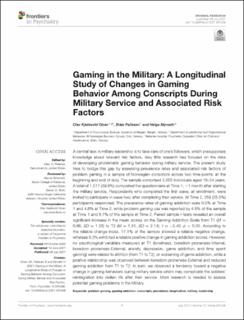| dc.description.abstract | A central task in military leadership is to take care of one's followers, which presupposes knowledge about relevant risk factors. Very little research has focused on the risks of developing problematic gaming behavior during military service. The present study tries to bridge this gap by assessing prevalence rates and associated risk factors of problem gaming in a sample of Norwegian conscripts across two time-points: at the beginning and end of duty. The sample comprised 2,555 individuals aged 18–24 years. A total of 1,017 (39.8%) completed the questionnaire at Time 1, ~1 month after starting the military service. Respondents who completed the first wave, at enrollment, were invited to participate in wave two, after completing their service. At Time 2, 259 (25.5%) participants responded. The prevalence rates of gaming addiction were 0.5% at Time 1 and 4.6% at Time 2, while problem gaming use was reported by 4.8% of the sample at Time 1 and 8.1% of the sample at Time 2. Paired sample t-tests revealed an overall significant increase in the mean scores on the Gaming Addiction Scale from T1 (M = 0.86, SD = 1.35) to T2 (M = 1.31, SD = 2.14), t = −2.40, p < 0.05. According to the reliable change index, 17.1% of the sample showed a reliable negative change, whereas 8.3% exhibited a reliable positive change in gaming addiction scores. However, no psychological variables measured at T1 (loneliness, boredom proneness-Internal, boredom proneness-External, anxiety, depression, game addiction, and time spent gaming) were related to attrition (from T1 to T2), or worsening of game addiction, while a positive relationship was observed between boredom proneness-External and reduced gaming addiction from T1 to T2. In sum, we observed a tendency toward a negative change in gaming behaviors during military service which may complicate the soldiers' reintegration into civilian life after their service. More research is needed to assess potential gaming problems in the Military. | en_US |

